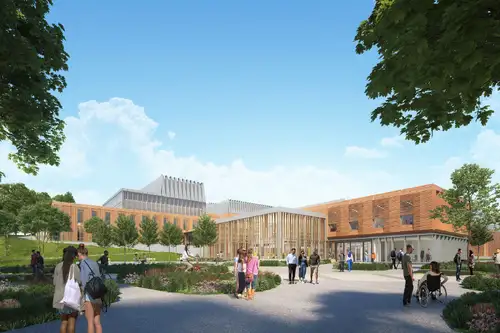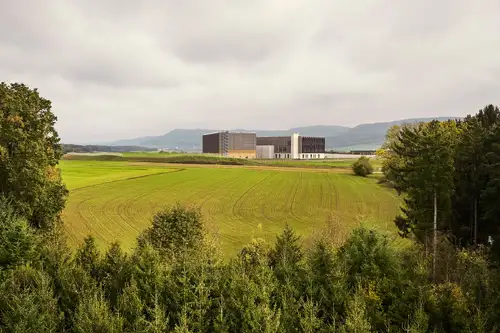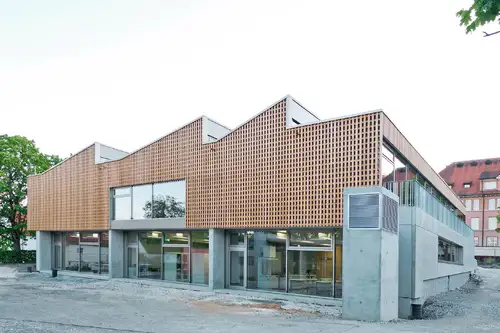What can we do against climate change?
One answer is to design and build climate-positive buildings.
CO2 Balance
Our solution approaches
If the goal is to contain climate change to +1.5 degrees Celsius, we know that we must plan and build in a climate-neutral way in the building sector. The difficulty is in defining neutrality. The impact on climate is not easily measurable. Attempts are being made to determine it through complex accounting calculations. However, system boundaries are viewed differently around the world and many terms are used inconsistently. Building-related emissions are usually accounted for over a year; in addition to heating and cooling, user electricity should also be included. If one thinks comprehensively, one considers the entire life cycle of the building and balances all energy-related processes and resulting emissions for the expected lifetime, including those of the building material (embodied energy), and evaluates possible reuse at the end of use before a new building is constructed.
Climate-negative
The conventional situation: CO2 emissions are not offset, whether from building energy use or embodied energy.
Climate-neutral
In climate-neutral operation, the production or purchase of renewable energy prevents CO2 emissions from energy use. More holistic climate neutrality also requires that embodied carbon is offset.
Climate-positive
The production of renewable energy not only covers the building energy use, but creates a surplus. Thus, CO2 emissions are omitted elsewhere; the overall CO2 footprint of a climate positive house is reduced year after year.
Our basic approach to date has been to reduce the amount of energy required as far as possible, while even improving comfort, and to cover the remaining use with renewable sources. In addition, we now expand the scope and analyze buildings, including their materials, throughout their entire life cycle.
Whether individual buildings or entire neighborhoods, it is possible to balance energy and thus also carbon dioxide, meaning climate-neutrality in operation. In addition, there are buildings that can produce a surplus of renewable energy, which allows them to be labeled 'climate-positive'. However, the CO2-problem is not linked to the operation of the building alone, but also to the materials of the building via the so-called embodied energy. It therefore makes sense to document the entire life cycle of a building on a balance sheet and reveal the entire CO2 footprint. One option for a building with a renewable energy surplus is to estimate the number of years required for the surplus to offset the embodied carbon, hence becoming climate-neutral from a holistic point of view.
Basic approach Climate-neutral or climate-positive in energy consumption

Let‘s build a house with a garden for the ideal client, who wants the project to be at least climate-neutral. Such an endeavor might seem manageable because the possibilities of influencing the building design and the equipment of the house are ideal. After determining the energy consumption for light and heat, we find the ideal locally accessible renewable energy sources. Of course, we compare feeding of temporary surplus electricity into the grid with the possibility of local storage. The result could be a climate-neutral, or net-zero energy building, because it does not consume more than it generates. Or it could even be a climate-positive single-family home, generating more energy than is needed over a balance period of typically one year, called a net-plus energy building.
Similarly, this can also be applied to the renovation of an existing building, which is already more difficult because, for example, the location and orientation of the building is predetermined, or sometimes historic preservation limits the possibilities.
If we now take a big step further and consider an apartment building or apartment blocks as an example, it becomes clear that there is an increasing shortage of space on the roof if photovoltaics alone are to supply energy there. There is a lack of renewable energy; it must come from the outside. In the ground, for example, heat and cold are available free of charge; they must be tapped and made usable via heat pump, driven with solar power. However, the renewable electricity cannot be generated on the property at all times in many latitudes and is therefore imported from the public power grid.

There are even more advantages to a planned urban development: Synergies can be exploited, local solutions can be created, energy supply systems and their potential can be analyzed, local heating networks can be laid for infrastructure measures and, where possible, roof areas can be positioned optimally and those in the neighborhood, e.g. those of multi-story parking garages, can be covered with photovoltaics to supply the surrounding area with electricity.
Heat recovery and demand-controlled ventilation, plus passive cooling, an efficient combination of strategies that is particularly suitable for buildings where there are sometimes many people – and sometimes none: schools, ballrooms, open-plan offices. Excess (waste) heat can also be stored for the winter. When operated on a large scale, this is particularly worthwhile.
Possibilities are therefore available. The basic prerequisite for their success is that someone must want them, and that is the client or investor. Return on investment should not be the top priority, but sustainability. For a municipality, for example, this means that it needs the opportunity to award the contract not to the cheapest concept, but to be able to vote for a sustainable solution. Going one step further would mean balancing the CO2 emissions of the building construction embodied energy.
DGNB Climate-positive – considering measured energy consumption

With 'climate-positive', the German Sustainable Building Council DGNB has created a clear term as a new rating for buildings and awarded it for the first time in autumn 2019. The society uses it to award buildings that, to put it casually, demonstrably generate more output than they consume during operation and uses the equivalent CO2 emissions as an assessment yardstick as follows:
„The CO2 emissions caused by the building and its use must be lower than the emissions avoided by the building‘s own production and export of greenhouse gas-free energy“.
Real measured energy consumption figures must be available as a basis for this and the certification is valid for one year only, because the quality of energy imports over the property boundary has been contractually agreed and may change. However, only buildings for which the values can be reported can be submitted for evaluation. Building owners, operators and users must therefore participate. An apartment building, for example, is difficult to submit if there are independent utility meters for each unit. However, due to the real data, the award is transparent and based on reality. And with the annual deadline, self-regulation remains attractive.
In 2019, six of our projects received this DGNB award, followed by others in 2020. If possible, we will continue to monitor the operation of the buildings that have received the award to date, look forward to extending the list with additional buildings by means of further annual results and thus look to the future in a 'climate-positive' manner.
However, DGNB 'climate-positive' rating does not yet consider embodied carbon. Other standards, such as the CaGBC Zero Carbon Building Standard, the International Living Future Institute's Zero Carbon Certification, or the E+C label 'Bâtiment à Énergie Positive et Réduction Carbone' of France, require that embodied carbon is also offset, which requires a more holistic approach.
Extended scope Minimize embodied carbon and offset the remainder

The term CO2 neutrality can be used on several levels: It can apply to the calculations of emissions of building-related energy demand alone – this consideration does not always include the energy consumption attributed to the occupants. Or the term may also include embodied energy: the sum of CO2 emissions associated with the construction of the building, maintenance and renovations throughout its life cycle, including demolition and disposal or recycling. The first possible offset is the generation of as much renewable energy as possible on site. Excess energy is then calculated as a CO2 credit. Purchased renewable energy or other forms of purchased carbon offsets can also be accounted for.

If we want to consistently reduce CO2 emissions in the building sector, the analysis of carbon dioxide emissions from buildings over their entire life cycle is required.
A holistic approach then includes consideration of all 'stages': design, material production, the construction process itself, facility use, maintenance and deconstruction, and recycling and reuse of the material.
The design phase determines how sustainable the building design will be and selects appropriate building materials with low energy and therefore carbon dioxide emission. In this process, the high energy used to produce a high-performance building envelope, such as krypton-filled double- or triple-glazed windows, can be offset by savings in the energy consumption of heating and/or cooling equipment.
Studies of the materials manufacturing stage show that wood materials have lower carbon dioxide emissions than concrete or steel, for example. However, as increasing deforestation worldwide has a negative impact on global warming, responsible action and sustainability must also be considered. However, if the mass of concrete is used wisely, it can be used to reduce air conditioning size and use, for sustainability and energy savings in operation. This benefit must be carefully weighed and varies depending on the climate zone. The preservation of existing load-bearing concrete elements, on the other hand, nearly always results in lower embodied carbon than building new.
Scientific studies point to the necessity of using local materials to reduce carbon emissions from the material and construction process stage.
The use of prefabricated materials in construction is also considered beneficial for reducing emissions as well as minimizing construction waste. The degree to which prefabrication makes sense ecologically depends on the individual case, as transportation plays a major role here. It must therefore be examined on an individual basis.
Materials and construction methods therefore play a major role in reducing environmental impact during the construction, utilization, maintenance and demolition phases of the building. When a conventional building is deconstructed, a large part of the energy required is for transportation. A long lifetime and easy re-use should be considered from the outset. The cradle-to-cradle concept (C2C) is a comprehensive approach where all building materials are reused in a circular economy, keeping energy consumption and greenhouse gas emissions low. However, the implementation of this principle in building practice is still in its infancy.
Although an all-encompassing life cycle assessment provides clarity and leads the way, it can still cause headaches. For example, if we analyze a building that is constructed with a lot of solid wood: wood scores well in the first three stages (product, construction process, and use) of the life cycle in terms of energy consumption and low CO2 emissions. However, since we do not know the end of life and only hope the wood will continue to be used, there is debate about how to handle the end-of-life. Should we assume the wood will eventually decompose or burn, so the carbon bound in the material is eventually released, and therefore need to include this emission in the carbon accounting?

Nevertheless, planners, designers, consultants and owners should broaden their field of vision and cooperate closely in solving these problems. With well-thought-out concepts, we can develop attractive buildings that combine economic efficiency and a high indoor environmental quality and think of sustainability beyond the building's end of life.
To ensure the greatest possible transparency, in the future we will show the comprehensive CO2 accounting for our projects, and if they achieve carbon neutrality.
Reducing carbon emissions Pioneering initiatives

For most of the world, information on the CO2 emissions associated with the creation of building materials and buildings is limited and inconsistent. Without a comprehensive and transparent database, life cycle assessment for buildings remains incomplete. At the same time, the enforcement of carbon emission thresholds for energy use has not lost priority and must be addressed in existing buildings. Certification processes and standards show a similar diversity of approaches, guiding the conversation in the professional community and exerting important pressure on policy makers and industry. In each country, for example, there is a need for close review prior to design: Does the carbon footprint and declared neutrality consider only the energy use of the building services or does it include plug loads? What types of energy generation are common in the country and how are they accounted for? What phases does the life cycle analysis include and how are building materials assessed?
New York City is taking a leading approach for addressing the carbon emissions of existing buildings with Local Law 97, the most ambitious building emissions legislation enacted by any city in the world. The law places carbon caps on most existing buildings larger than 25,000 square feet – roughly 50,000 residential and commercial properties across NYC. Buildings with emissions exceed the cap must pay a fine, calculated according to how much they exceed the cap. These caps start in 2024 and will become more stringent over time, eventually reducing emissions 80 percent by 2050.
France is pioneering a new approach in Europe: Requirements for energy-positive and CO2-negative buildings are being introduced in the new French energy code Réglementation Energétique (RE 2020) after being piloted in a voluntary labeling system (Label E+C) since 2016. In addition to the energy consumption of new buildings, the new RE 2020 will regulate the carbon footprint of building operations and require life cycle assessment of construction materials and equipment. Greenhouse gas emission limits on new buildings favor electricity use, reducing CO2 emissions from oil and gas boilers. As in New York, the limit will be lowered over time, with added limits on total energy use to discourage the use of inefficient electric resistance heating. In addition, the RE 2020 will restrict the carbon emissions of building materials and equipment over a life span of 50 years. One major adjustment from the pilot label to code: the carbon thresholds set for materials and construction will leave room for concrete, cement and brick, provided that they reduce their emissions by 34% by 2030. The RE 2020 will come into force at the beginning of 2022.






























